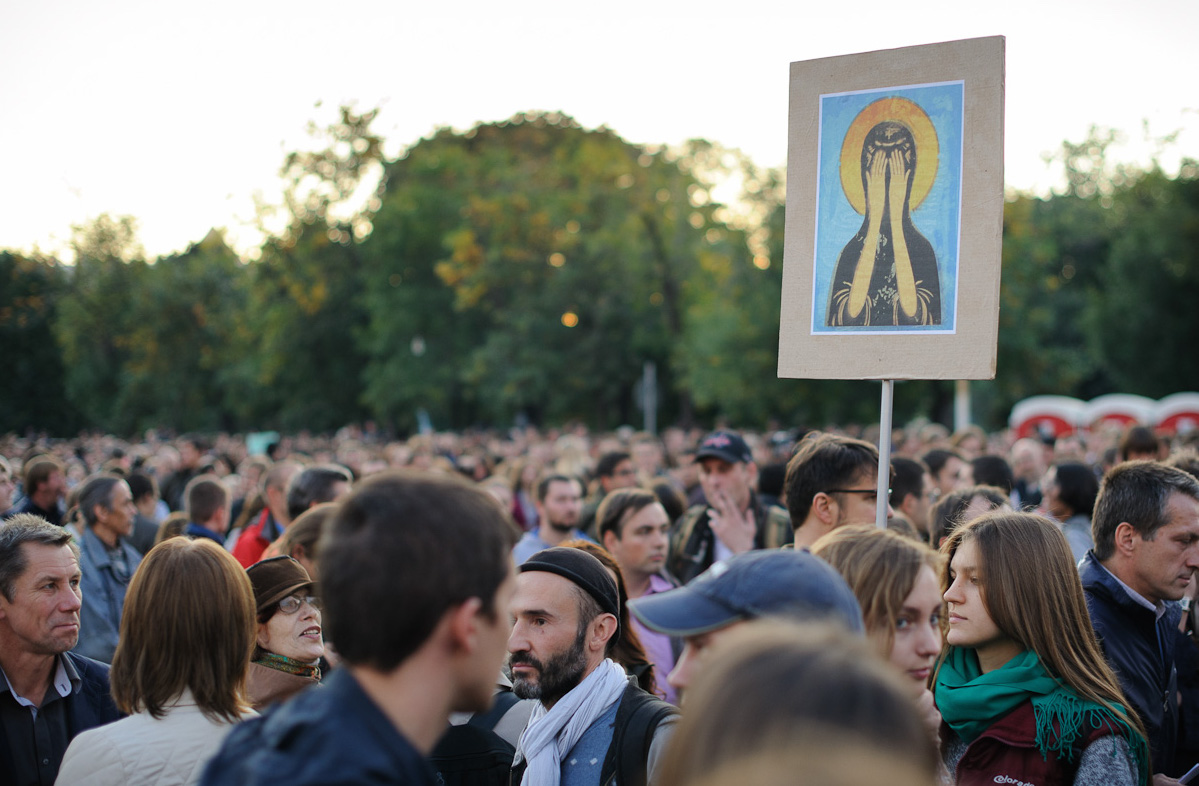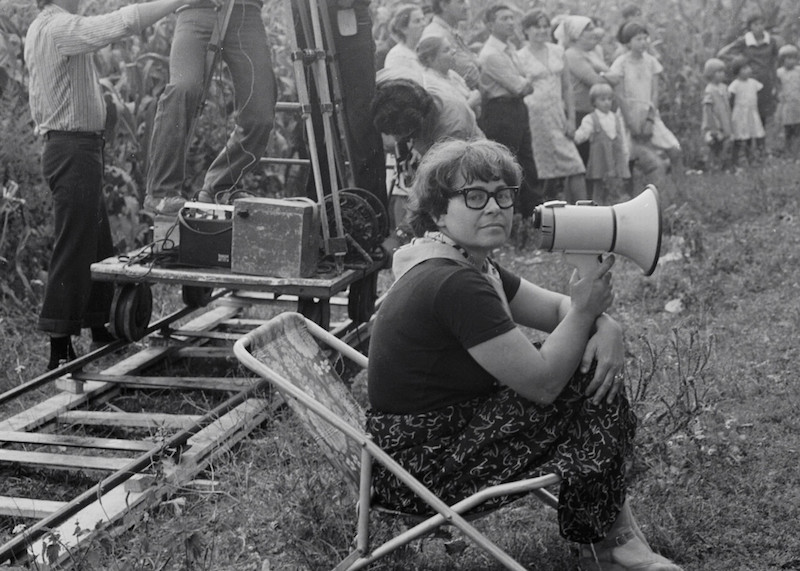Why we shouldn’t be celebrating the release of Dau, the troubling epic 14 years in the making
Ilya Khrzhanovsky’s Dau has become one of the world’s most eagerly awaited and controversial film projects. Now the maverick director’s “experiment” has finally been unveiled in Paris, it’s time to ask: was it worth the trouble?
Last week, Paris’s venerable Théâtre du Châtelet and Théâtre de la Ville opened their doors to the public in the culmination of an artistic project that has been rumbling and roiling since 2005: Dau, the biopic of Soviet physicist Lev Landau that became a sprawling exercise in world-building and the theory and practice of power. For those invested in the world of post-Soviet culture, and film in particular, Khrzhanovsky and Dau have long since entered into folklore. Nominally at least, the ongoing “experiment” on offer in Paris should provide a kind of closure, following years of rumour and secrecy. Those trying to follow Khrzhanovsky’s work have relied on occasional reports in the Russian press and extremely selectively granted interviews, seemingly permitted only when there has been a need to remind the world at large that Dau was not, in fact, just some giant prank.
Anyone paying attention to these titbits has known for years that Dau has been defined by a morbid relationship between director and cast and production crew, and marked by numerous allegations of misconduct. Yet now that more concrete information and actual footage is being released into the world, it’s becoming uncomfortably clear the extent to which Khrzhanovsky has been indulged. In 2019, after the painful advances in accountability and representation manifested in movements like #MeToo, are we still willing to excuse the excesses of men in the name of artistic ambition or “genius”?
Teodor Currentzis as Lev Landau in “the Institute”. Image © Phenomen IP 2019. Photographer: Olympia Orlova
Dau’s production history is one of spiralling ambition — and an ever-tightening fixation on control, with all the dangers that entails. Largely financed by telecom oligarch Sergey Adoniev, Dau was initially conceived in 2005 as a biopic of Nobel Prize-winning scientist Lev Landau, a free love advocate and ground-breaking quantum physicist. Teodor Currentzis, a maverick Greek conductor feted for his work in the Ural city of Perm, was cast as Landau. In 2009, after a year of shooting, “the Institute” was built: a mammoth stage set in what had once been a swimming pool on the outskirts of the eastern Ukrainian city of Kharkiv, which was to stand in for the secret research centre (actually in Moscow) where Landau worked until his death in 1968. At some point, Khrzhanovsky put the biopic aside to immerse himself in the directorial possibilities of this Soviet simulacrum.
Dau’s production history is one of spiralling ambition — and an ever-tightening fixation on control, with all the dangers that entails
This was when Dau become a myth in the making: “The Movie Set That Ate Itself”, “Apocalypse Dau”, “the Stalinist Truman Show”, ran headlines. Khrzhanovsky and his casting assistants populated the Institute with thousands of non-professional-actor “participants”, who were instructed to carry out their real-life occupations within a reimagined, mid-century Soviet Union. Waitresses were hired to run the Institute’s cafeterias, former KGB officials its police force. The Institute’s scientists were joined periodically by academic heavyweights like physicist David Gross and mathematician Shing-Tung Yau, and by cultural luminaries including Marina Abramović, under the same strict instructions. Outfits, food, scientific equipment, even plumbing were strictly controlled for historical authenticity — and adjusted over time, as the Institute “moved” forward from 1938 to 1968. And while most rooms were rigged with microphones, only a single cameraman (German cinematographer Jürgen Jürges) roamed the set with a skeleton crew, capturing 700 hours of footage from 2009 to 2011. Mostly, life just went on: a rigidly-policed, painstakingly naturalist period drama populated by real people.
The seven-year-long post-production period, managed by Phenomen Films from swanky London addresses, was equally epic and secretive, and subject to the same dark rumours of managerial excess. Dau’s grand unveiling in Berlin last autumn was foiled just days before time, allegedly due to paperwork issues. In Paris, visitors to the Théâtres will be required to buy a “visa” and complete an online survey, which will be used to prepare a personalised, non-negotiable itinerary for them through a maze of reconstructed Soviet apartments, video booths, musical performances, and more. Khrzhanovsky is clearly not giving up control just yet.
The set for Dau has been described as a “Stalinist Truman Show”. Image © Phenomen IP 2019. Photographer: Jörg Gruber
It’s control that is at the heart of Dau’s darker side, in terms both of the working environment in Kharkiv and then London, and the content of the films themselves. Tales of the Institute thrilled many distant onlookers, who saw Dau as the heir to such legendarily wayward shoots as Apocalypse Now, examples of an eccentric artistic ambition that couldn’t be damped down by logistical demands. But at least Francis Ford Coppola was sweating it out in the jungle (and spending his own money).
Reports from the Institute when the set was still extant, such as Michael Idov’s 2011 GQ essay or Colta’s 2010 interview series with former employees, depict Khrzhanovsky as leaning into the role of a petulant and whimsical dictator while the small army of technical staff laboured in physically and emotionally turbulent conditions: Colta’s interviewees recount 16-hour working days, jobs offered and then taken away at no notice, terrible pay that arrived late, and an inscrutable boss who offered no clear direction other than demanding fealty. “V.”, a production coordinator, tells Colta that “the simplest things [there] are transformed into some kind of perfect hell.” A former worker describes being on set to Idov as “like being that guy who wanted to be killed and eaten, and finding a maniac who wants to kill and eat you.” Working in — or even visiting — the London offices was subject to ongoing NDAs, but there are unverifiable accounts to be found (on this recruitment agency site, for example) that posit a hierarchical work culture of intimidation and blurred boundaries.
In an excellent recent piece for The Guardian, the journalist Steve Rose presses Khrzhanovsky on allegations ranging from hiring and firing young women on the spot, to questioning at least one girl about her sexual past in an interview and dismissing her when she was reluctant to answer. The director denies any abuse, but he does admit that, in casting interviews, he discusses sex — “this is important, because we don’t work with actors but with real people. You talk to them about life” — and says he has no regrets about his treatment of women he has worked with.
Image © Phenomen IP 2019. Photographer: Olympia Orlova
Some will no doubt argue that, with these kinds of folies de grandeur, the ends justify the means; that all film sets are chaotic places to work, and that Khrzhanovsky’s aspirations are valid. Reading about the footage that has been unveiled so far, I am dubious. There is a great deal of unsimulated sex. Animals are slaughtered in front of shocked onlookers. Rose reports watching footage of a woman being stripped and violated with a cognac bottle in a prison. The sell with Dau is that these are not actors and that they are not “acting” — they are living out scenarios that are only indirectly created or influenced by Khrzhanovsky or the camera crew. This violence is “real”, and the parameters of consent at play are practically impossible to verify.
When you are providing actual fascists with a playground in which to assault people, you are no longer questioning the injustices of the world but amplifying them
The world of the Institute was destroyed when it reached “1968”. In a film seen by Geoffrey Macnab, writing for Sight & Sound, the director of the facility brings in soldiers to put a stop to the decadence of its inhabitants; these young men proceed to terrorise and murder the scientists before destroying the compound. (The film crew celebrated this by bringing in electro-pop star Peaches for a one-off concert in the ruins.) Le Monde reported that these “soldiers” were in fact genuine Russian neo-Nazis, headed by notorious fascist leader Maxim Martsinkevich, currently serving 10 years behind bars, who the report alleges attacked and sexually assaulted Andrew Ondrejcak, the American assistant of Marina Abramović. Ondrejcak told Le Monde that he was too traumatised to comment; as the paper quotes Khrzhanovsky: “Andrew arrived with the aim of exerting an influence on the neo-Nazis, but they were the ones who influenced him.”
Real-life violence has a place in art; there are legitimate reasons to perform it in order to provoke debate. But when you are providing actual fascists with a playground in which to assault people, then you are no longer questioning the injustices of the world but staging and amplifying them. Why this is where Khrzhanovsky’s reverie led him is another matter. It’s not enough to argue that the director simply stared too long into the Soviet abyss and became a mini-Stalin by osmosis. These films cannot be described as, and were not intended to be, a “realist” representation of Soviet life. Khrzhanovsky has himself said that Dau “is factually speaking about contemporary life”. We can’t distance ourselves from abuses of the present with deferrals to Soviet boogeymen of the past.
Image © Phenomen IP 2019. Photographer: Volker Glaeser
Khrzhanovsky is, by his own admission, interested in power, but also the ability to evade its clutches — the freedom that comes from what he calls “genius”. “Genius people are, for me, like kind of ancient heroes. They got a gift from the gods,” he tells Rose. This is a line of reasoning he has raised before — in an interview with Sobaka, Khrzhanovsky claims: “Ancient heroes deceived people, lied, killed, and were at the same time beings of the highest morality — they simply lived according to different laws.” Is it acceptable to muddy moral boundaries just because you think your “heroes” were justified in doing so? Whether or not Khrzhanovsky considers himself a genius — he tells Rose that he is not — he is clearly willing to push beyond the limits of ethical probity in order to capture this chimerical, self-validating quality. This is a line of thinking we should have long left in the past — given the revelations that have rocked film in the past few years, there is no excuse anymore to go along with it.
In Novaya Gazeta, the columnist Anna Narinskaya has pointed out that Dau “was an experiment whose failure would also be taken as a success”: it put its participants through distressing scenarios in order to show things as they “really are”. Except when it decided not to — or to bend its self-imposed rules. But this problem stems from its creator, not its audience. Do we really need to cling to the notion of the singular, male genius, when there are Nazis on the rampage? Khrzhanovsky has built an enormous and voracious machine for revealing our flaws as onlookers, and for hiding his own in plain sight. At least it is now up to the public whether or not to participate.


